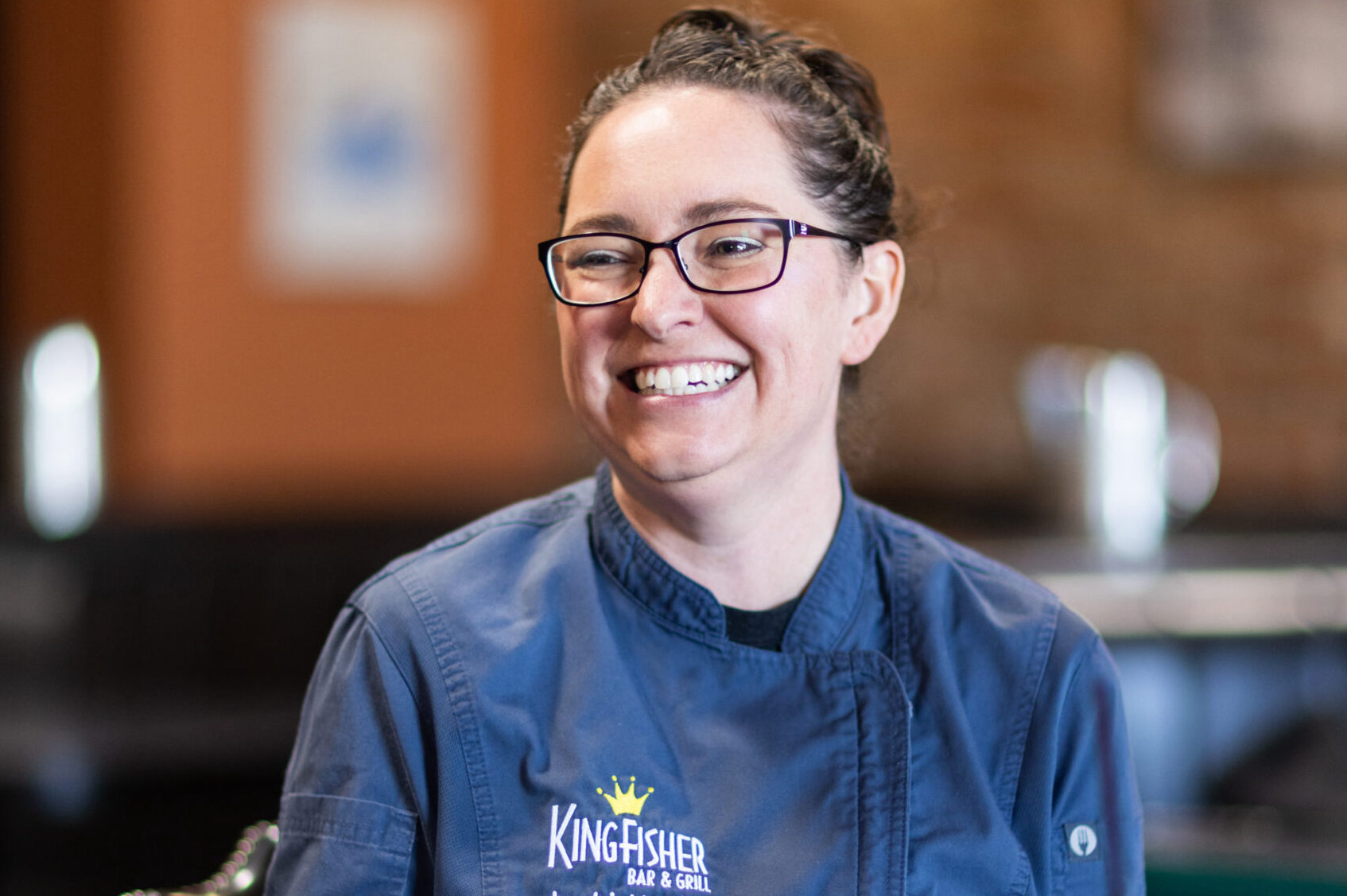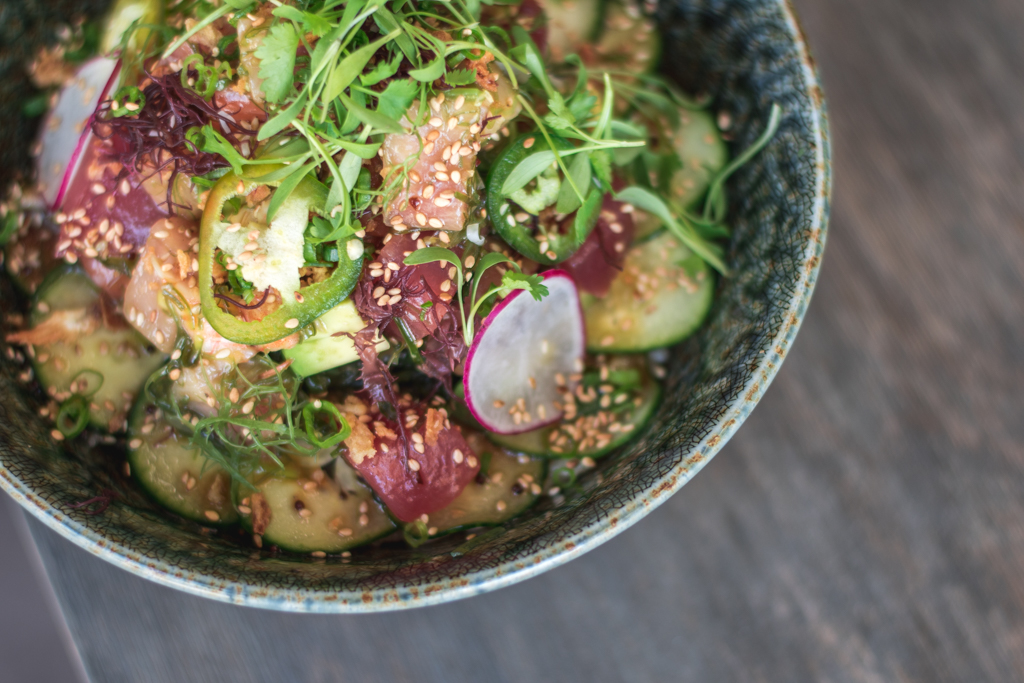
Paulo Im is Executive Chef and Partner at OBON Sushi Bar Ramen. Im has been cooking all of his life and has held the title of chef for ten years.
In the past, Im worked at Sakana Sushi in Phoenix, Ra Sushi, and Yuki Sushi before Yuki Watabe retired. On his second stint at Ra Sushi, he went on to become the head chef where he met Brandon Katz, who is now his partner at OBON.
What was the first dish you had that changed your perspective on food?
It was a small morsel of food. One course out of twenty at the three-Michelin-star-rated, The Chef’s Table at Brooklyn Fare. The dish was a brioche with Japanese uni, a generous serving of Australian black truffle and Sturgeon caviar. That bite showed me who I was as a cook and it was not those things. It was insanely delicious, but it perfectly juxtaposed who I was. I had eaten uni plenty of times, but nothing like that.
The preparation for that dish was simple because the ingredients were so luxurious. I grew up cooking humble food with ingredients like tripe, oxtail and off cuts of meat. That’s not to say that I don’t want to dabble with finer food, because I absolutely do, but at the time, I was able to see the polar opposite of the gastro spectrum.
What are you eating these days?
On my days off it is usually Korean food at home or the wife and I will go out to eat on occasion. I am crazy about the Chili oil Schezuan fish at Jun Dynasty. It’s perfectly poached fish in a hot cauldron of hot chili oil, napa cabbage, and the most aromatic peppercorns that make you salivate while numbing your mouth. I didn’t like it at first but I found myself craving it, and now I am addicted.
Other than that, most days when I am working, it’s usually rice, eggs, kimchi with a touch of sesame oil. It’s convenient and really delicious.
What was the first dish you remember cooking?
Let me provide some context. I started cooking complicated dishes from the get-go out of a necessity. It was so my family can eat proper meals. My mother taught me how to make Korean food when my father had a severe stroke and her Parkinson’s disease wore her down. I was just eight years old.
The very first dish she taught me how to make is called Mae-un Tang which translates to spicy broth. It’s a spicy seafood stew with a lot of depth. I had to make that dish, and all family meals from scratch. My mother was a professional cook herself before she became sick. In a way, she was the first chef I cooked for. I still have a knack for making killer Korean stews.

What concept, ingredient or food trend does everyone seem to love, but you just can’t stomach?
For sushi chefs, there is a holy trinity of sauces that we consider an abomination. Sriracha, eel sauce and spicy mayo.
Put yourself in my shoes. You are a zealous chef on the hunt for stellar fish, worthy of your diners. In order to get said fish, you need to have a great relationship with your distributor that took years to develop. You haggle with her, and tell her to keep an eye out for a particular fish like, I don’t know, let’s call it wild Albacore. You put in a request and they keep you updated on the status of the fish, and to your delight, they finally caught one in Fiji, and she tells me it will come in three days.
You receive the fish on delivery day, and bask in its glory. It is perfect. Clear eyes, the gills smell like fresh blood. You apply your craft that you have honed for ten years to the fish. A perfect fillet. You taste a piece and you notice that it is fattier than usual, so you decide to serve it with ponzu and yuzu kosho and fresh wasabi to achieve that balance. It is firm enough, so you do not need tataki or to sear the meat. A rookie might have done that, but you know better. The sear will only disrupt the unique texture.
Then some guests come in, not knowing how special their food is, because it doesn’t contain a buzzword like Toro or Uni, but asks what’s good. You suggest the wild Albacore, and you hear those dreaded words, Can. I. Get. A. Side. Of. Eel. Sauce? I pass them the horcrux of a ramekin containing a piece of my soul. It’s not hyperbolic, it’s just wrong.
What chef, with us or passed on, would you most like to cook or eat dinner with?
Cook with – Paul Qui from Qui in Austin and former Executive chef of Uchiko. I feel like there would be a great deal for me to learn from him, and he is someone I model myself after.
Dine With – Fredric Morin and David McMillan of Joe Beef in Montreal. They are quintessential gluttons of Montreal. They carry satchels of truffle and eat homemade boutique sausages and fine wine at their pick-up hockey games; creators of the sandwich one-upping the KFC double downer using breaded, fried grade A foie gras as buns in a bacon sandwich. Sign me up.
What city, other than Tucson, is your favorite place to eat?
I love eating in cities with a strong presence of immigrants. That’s where the best food is. Korea town in Los Angeles, Chinatown in New York, or Vietnamese food in Dallas or San Francisco. That kind of food is for the locals. It is for people that miss the flavors of home, so they had to make home happen here. These food havens have been around for a long time and are finally getting attention.
Speaking in junk food terms, what is your favorite guilty pleasure?
Instant ramen – add eggs and scallion, good to go
Waffle house – preferably at 2 am
Most important on my list, Spam!
Spam. It isn’t trendy. It’s delicious. I’ve been judged for eating spam. I don’t care. I’ve had health conscious FOH staff in past restaurants I’ve worked in tell me how disgusting I am for eating spam. I told them to go fuck themselves. It is a part of Korean peasant culture to eat spam. If you don’t believe me, I will cook with spam for you and you’ll understand how much potential it has. It is versatile. It pairs well with pickles, kimchi, eggs, rice. Put it in a baguette with jalapeno, cilantro and daikon with fish sauce and hoisin to make a poor man’s bahn mi, I guarantee it will taste better than your shitty PB&J.
I know I am a chef. Spam is processed. Spam is unhealthy. But spam is special to people. Look up Budae Chigae in Korea, Spam musubi in Japan and Hawaii or Filipino Spam sliders from Jollibee. It is a beloved product embraced everywhere but mainland USA.
Fun fact: did you know that Spam is better than bacon? It’s not an opinion, it’s a fact.
Top three Tucson Restaurants?
1. Downtown Kitchen & Cocktails. Chef Janos Wilder. I stumbled into his restaurant when I was younger. He saw that I was in the industry and brought out several plates that I did not order; a pounded papaya salad, lamb tongue tacos and foie bon-bons. It showed me how you ought to treat others in the industry, and also why he is the God father of local chef scene. He recently visited my restaurant and I really wanted to show him how much that meant. His gesture helped put me on this trajectory. His current project with Chef Devon Sanner (The Carriage House) is all about bringing the community together through cooking classes and events showcasing a local chef. I think that that makes him the most important chef still today.
2. Prep & Pastry. Yeah it’s just brunch, right? Wrong. I have respect for their cooks. The volume and numbers they are doing are incredible. I haven’t seen their BOH set up, but I know for a fact that it takes a special kind of chef or cook to run that kitchen. I’d like to think I come from a background that handles high volume, but think about it. It’s eggs, hash, toast, etc. and their numbers are one of the highest in town. The check average I’m assuming isn’t, which means they earn every dollar from every guest, one plate of hash and eggs at a time and everyone that dines there is happy.
3. Tie between Kung-fu Noodle and Jun Dynasty. Any place that will make food from their region unapologetically are heroes in my book. The menu does not cater toward a western palate. Nothing is dumbed-down or easy on flavors. It is spicy, funky, aromatic and sometimes offensive, but it’s the best.
With a figurative electric chair in your immediate future, what is your last meal?
Gul (oyster) Bossam is a dish from the Korean country side. The dish comes from Kimchi farmers who would receive slabs of pork. The dish consists of braised pork belly or shoulder with fresh oysters served with steamed then chilled napa cabbage, condiments of Ssam sauce (a spicy funkier miso), raw garlic, sliced peppers, young daikon kimchi and super briney pickled daikon, and baby brined shrimp. Wrap it all together in the cabbage then stuff the whole thing in your mouth. Whenever I eat that dish, I remember who my people are and where I come from. Pork belly isn’t trendy for me. It was a staple in my diet growing up.